HD672
back to Superlux
back to measurements
home
Published: Feb-17-2018
NO SMOOTHING is applied to the shown plots. Most measurement sites have some smoothing applied which ‘irons flat’ sharp peaks and ‘wiggles’. I do not use smoothing because some info about sound quality is lost when plots are smoothed.
Aside from a small correction of the microphone itself also some correction in the lowest frequencies is applied to the plots to compensate for the perceived loss of bass when using headphones. This is described HERE in more detail.
A ‘horizontal‘ frequency response curve on the shown frequency response plots on this website thus indicates a perceived ‘flat’ tonal signature.
ALL measurements are made with a good SEAL on a flatbed measurement rig.
The shape of your head, bone structure, pad size, pad ‘softness, (compliance), hair or no hair and or wearing glasses may (drastically) change the frequency response of some headphones, so… your personal experience may differ substantially from these plots.
Frequency response (tonal balance) is the most sound-determining aspect of headphones. A horizontal line shows audible neutral response in the plots on this website. Deviations in different severities at different frequency bands have an effect on the sound character.
The bigger the deviation the stronger the effect.
Below an aid to help determining the sound character of headphones with relation to the frequency response.

Superlux HD672

specifications
Type: Over ear, semi open
Usage: Home, studio, portable.
Driver type: dynamic
Pads: replaceable, silicone alike composite material
Inner Pad dimensions: depth = 18mm, ø 60mm
Collapsible: No
Headphone connector: none, fixed cable.
Cable entry: single sided (left)
Cable: 2.5m terminated in 3.5mm TRS with screw-able 6.3mm adapter.
Driver size: ø 50mm
Nom. power rating: unknown, assumed 0.2W
Max. voltage: 2.5V (assumed 0.2W)
Max. current: 80mA (assumed 0.2W)
Max. S.P.L.: 118dB (assumed 0.2W)
Impedance: 32 Ω
Efficiency: 95 dB @ 1mW
Sensitivity: 110dB @ 1V
Weight: 230 g. (with cable 280 g.)
Colour options: black and white
Clamping force: low (4.5N)
Accessories: Ø3.5mm to Ø6.3mm gold-plated connector, cloth carrying bag
Description
The Superlux HD672 is a semi-open dynamic over-ear headphone intended to be driven directly from desktop and portable equipment.
The difference between semi-open and open headphone is not very big. When a headphone is ‘fully’ open the rear of the driver is able to emit sound directly to the outside world sometimes only separated by an open screen or mesh.
When a headphone is semi-open the driver is in a cup that has some openings to the outside but is otherwise largely ‘closed’.
A semi-open headphone has some attenuation from outside noises, an open version does not.
It will probably retail for around $ 35.- which is quite affordable to most people.
For this you do get a modern looking, light-weight and to most people comfortable headphone.
It will be available in white and black.
The cable is 2.5m long which is somewhat on the short side for desktop duty and way too long for portable usage. It is non replaceable and only very slightly microphonic. This means mechanical noises from the cable rubbing on clothes etc. are heard only softly in the left earpiece.
The headband is comfortable and self adjusting over a reasonably wide range.
This is achieved by a elastic-band hidden inside the headband. The adjustment range is quite good and better than the HD681-EVO, HD662-EVO, HD687 & HD688. The construction seems decent. I have no idea how these elastic bands will age though.
Isolation from outside noises is decent for a semi-open headphone.
Others around you can still hear what you are playing but not at an annoyingly loud level. Don’t expect much isolation from ambient noises.
The ear-pads are what this headphone sets aside from (all ?) other headphones. They seem made of silicone. Superlux calls it ‘composite material earpads’ and are at least innovative. Easy to clean and won’t flake after a few years like a lot of pleather pads do.
They are quite soft as there is no foam inside which often decays over time. It gets its flexibility from its shape and thickness.
More about these pads can be read in this PDF file that can be downloaded.
Sound description
Out of the box the HD672 does not disappoint.
The overall sound is quite neutral, clear and very dynamic. Instruments sound quite realistic and are well separated.
The bass is there and sounds ‘tight’. Sub-bass sounds extended enough. Bass is slightly rubbery, most likely caused by the pads.
Mids have a good clarity and detail to them and sound very neutral. Voices jump out and sound very ‘open’ and well placed. For this price class a well balanced sound.
The treble is accentuated which makes it sound very detailed but at the same time can be a bit too sharp sounding on some recordings.
With some recordings the sound even has some 3 dimensionality about it.
The HD672 can play pretty loud before sounding nasty (starting to distort). Of course this is also dependant of the maximum output voltage of the source.
Measurements
Below the frequency response of the HD672 (Left, Right)
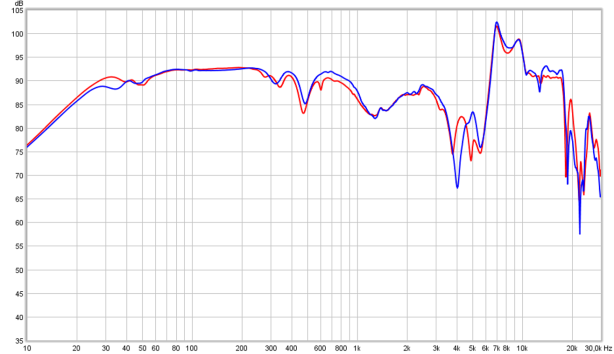
This does not look spectacular at all. There are plenty of headphones around that measure better but not necessarily sound better.
Bass extension is quite good and goes down to 25Hz. From 30Hz to 1kHz the frequency response is quite linear. Integration of bass and mids is seamless. The small dip around 1.5khz is not really audible due to the rise in amplitude to 3kHz.
Above 3kHz the HD672 shows some ‘problems’.
A dip with some resonances up to 6kHz with a massive resonance at 7kHz. It is not really desirable to have a peak in that part of the frequency range as ‘sibilance’, ‘edgy sound’ and unnatural brightness is in that area (see the previous page).
The treble itself does not have many deep peaks and dips but is reasonably well behaved till 20kHz. Highs thus have enough ‘air’ and ‘resolution’.
The HD672 is fairly insensitive to loss of seal. Good seal, with glasses, with thick arm glasses and a seal breach.
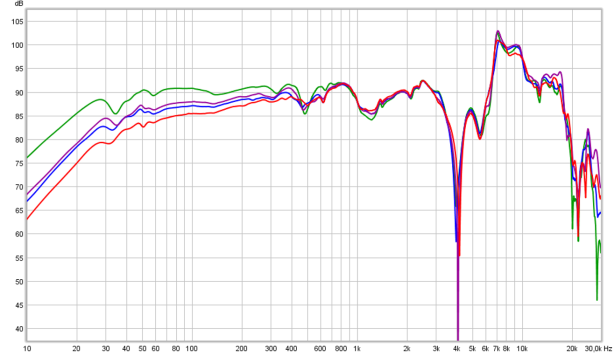
When the seal is breached (a gap between pads and head) some loss of bass levels is observed. The severity depends on how much of a gap there is .
When wearing glasses the bass levels drop about 4dB which is audible.
A good seal is important. When a pad is not touching the skin in one or more places the seal is fully breached and bass levels can drop over 6dB.
Below the distortion measurements of the HD672 (Right channel).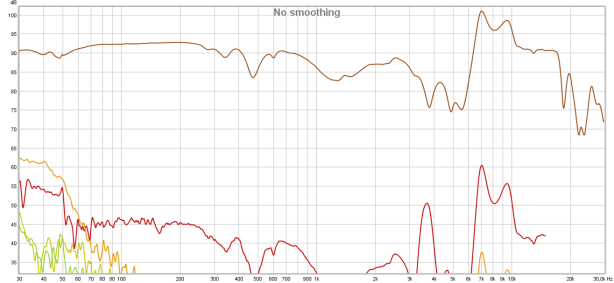
Below the same distortion plot but displayed in percentages.
The overall distortion is decent. In the lower bass area the 3rd harmonic distortion is high. 5% is audible. Above 60Hz the distortion is already lower than 2nd harmonics and below 0.5%.
Another soar point is the area around 4kHz. The distortion reaches 4% but in a rather narrow band.
This may well be audible with some recordings. Also around 7kHz there is some distortion (reaching 1%) and ringing (see other measurements below).
For a headphone in the lower price class these values are nothing to be ashamed of.
Below the CSD of the HD672 . (Left and Right are superimposed)
There is a lot of lingering at lower frequencies. At 500Hz the amplitude does not go down fast enough. This seems to be caused by the pads. At 3kHz some ringing is visible.
This driver resonates at 7kHz.
Above 7kHz the response isn’t bad though and there are no alarming resonances seen.
This peak at 7kHz not only consists of a peak in the frequency domain but also in the time domain.
Below the spectrum plot of the HD672 (Right channel). This plot is a bit like the CSD but looked at from above where the amplitude is colour coded and the time line is from bottom to top instead of rear to front. Also a wider part of the frequency range is visible.
The area between 400Hz and 800Hz shows some lingering. At 1.3kHz, 2.5kHz, 5kHz and 7kHz resonances are visible.
The step response (Right channel) below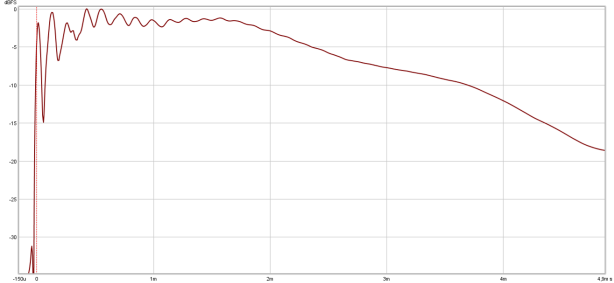
This plot shows how the driver reacts to a jump in position from ‘central’ (no signal) to a position similar to producing about 90dB SPL.
The initial rise doesn’t reach the 0dB line but reaches -3dB and has some serious ringing.
It still rings visibly up to 3ms.
The sub-bass response is decent and only lacking a bit below 30Hz shown by the drop in the horizontal line.
Below the square-wave and impulse response plots of the HD672.
The 40Hz oscilloscope shot shows the sub-bass extension is not excellent. The 440Hz square-wave shot doesn’t look like a square-wave at all. It looks more like a bunch of 7kHz ringing somewhat following the applied signal.
The 100μs pulse overshoots and isn’t the correct width. The ringing following is is almost of equal amplitude and rings on for quite some time.
I am actually amazed that a headphone with this kind of response still sounds good.
output resistance / damping-factor
As this is a low impedance dynamic headphone the frequency response might be amplifier output resistance dependent when certain higher output resistance amplifiers are used. In the high-end desktop amp world chances are higher that you can encounter a high output resistance amplifier.
To test this the headphone is measured via a low impedance amplifier (0.2Ω) and a high impedance amplifier (120Ω). On a higher output resistance amplifier the output level will be slightly lower. To compensate for this the amplifier is cranked up a bit to the same level (at 1kHz) as the low impedance amplifier. This way the plots are overlay-ed and it is easy to see how the tonal balance changes.
It looks like a higher output resistance of the amplifier (or portable equipment) has no influence at all on the tonal balance. The impedance plot thus is very ‘flat’.
The HD672 also exists in a closed version (HD671) which, to me, is the lesser sounding one. Below the HD671 versus the HD672
conclusion
The Superlux HD672 does not measure extremely well. The sound, on the other hand, is quite good.
Even though the pads have something going for it to me they have more down sides than upsides.
Comfort of the headphone is good and so are the looks.
The lack of movement from the cups, the long fixed wire and pads are downsides that may put some people off.
The good news is that the pads can be changed into something more pleasant (velours) and the sound quality can be improved significantly with just a few simple modifications.
modifications
An indepth analysis with modifications can be downloaded HERE
Below a small preview of what can be achieved with this heaphone with a pad change, a bit of toilet paper and some malleable eraser which does not require any skills or opening the headphones.

Below the frequency response of the modified version shown above.
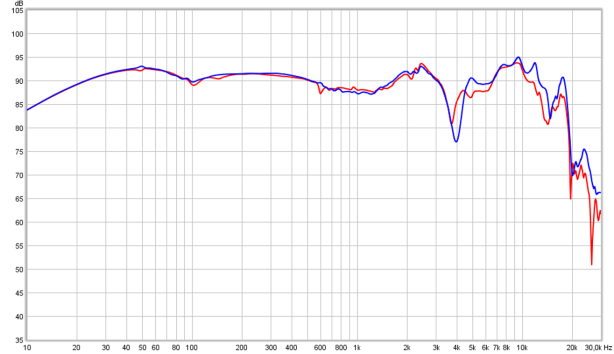
Most of the poor measurements are caused by the innovative pads. Obviously development of these pads still has a long way to go.
The driver itself has some issues but not nearly as much as the early prototype I received.
This time the production model, at least Superlux said this is a production model but indicators are there to think it still is a prototype, is much better sounding than the early prototype.
It still looks like Superlux’es goal of making good performing equipment for low prices is again a step closer.
